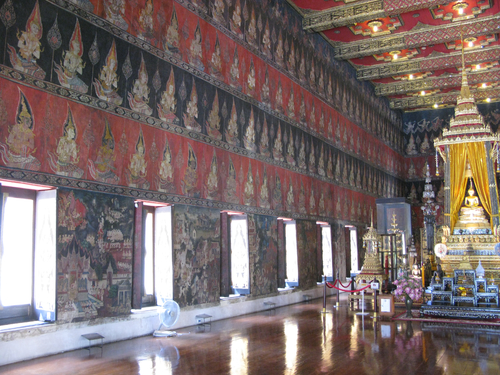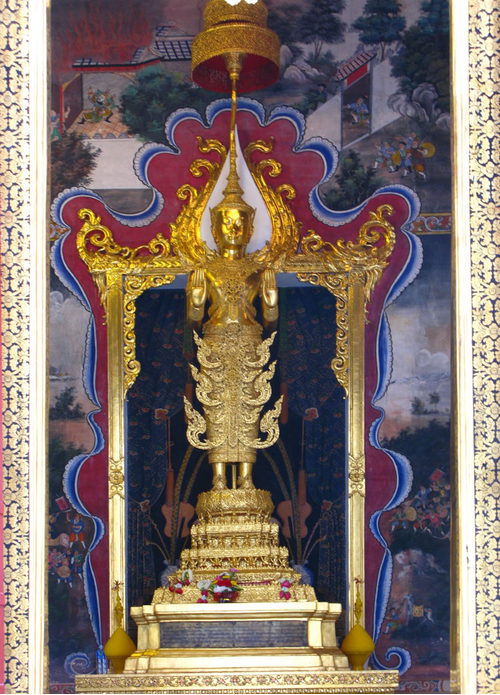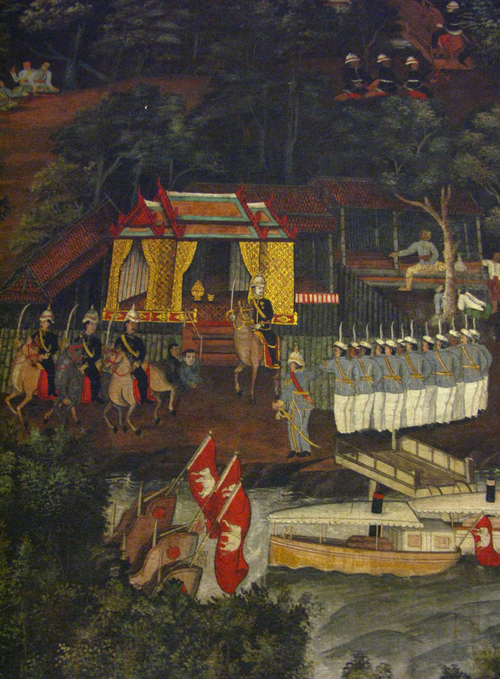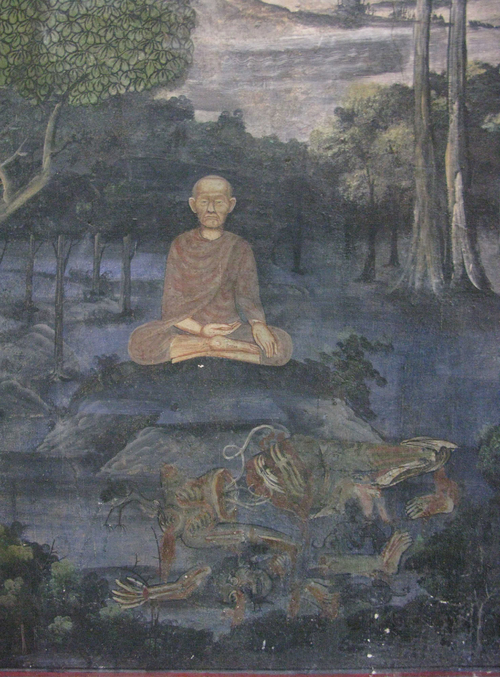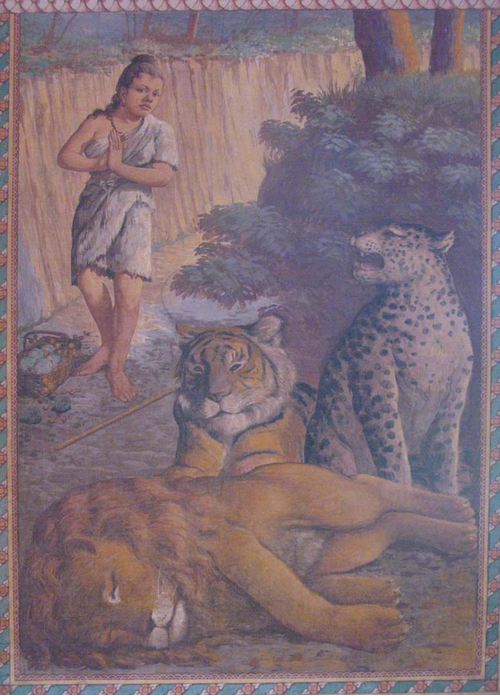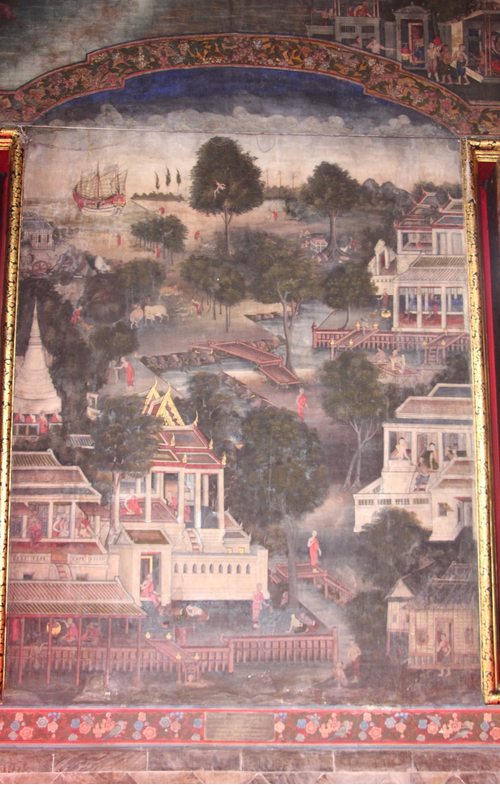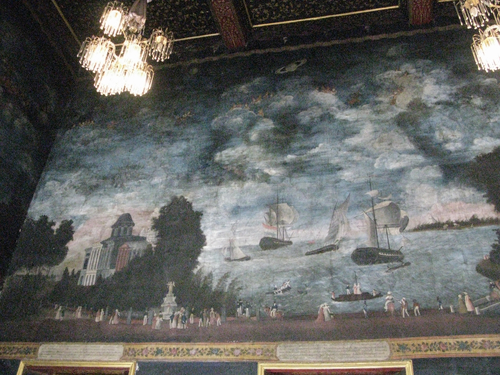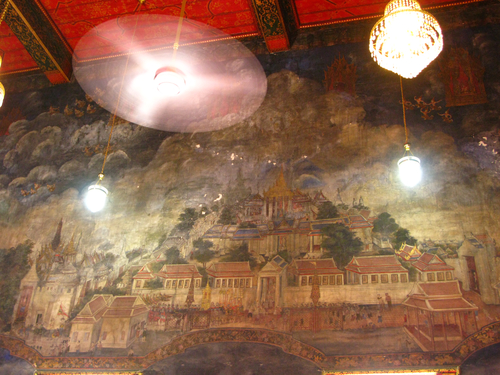ค้นหางานศิลปกรรม
ฐานข้อมูลศิลปกรรมในเอเชียตะวันออกเฉียงใต้
จิตรกรรมจิตรกรรมฝาผนังเรื่องพุทธประวัติและเทพชุมนุม
จิตรกรรมฝาผนังที่พระที่นั่งพุทไธสวรรย์มีรูปแบบเป็นงานจิตรกรรมไทยประเพณี เขียนภาพเล่าเรื่องพุทธประวัติที่ผนังระหว่างช่องหน้าต่างส่วนผนังเหนือช่องหน้าต่างเขียนภาพเทพชุมนุมโดยเหล่าเทพเทวดาแต่งกายยืนเครื่องอยู่ในท่านั่งเรียงเป็นแถว ต่างพนมมือเพื่อกราบนมัสการพระเจดีย์จุฬามณีบนสวรรค์ชั้นดาวดึงส์ซึ่งมีภาพพระเจดีย์ที่ผนังท้ายพระที่นั่งส่วนผนังด้านหน้าพระพุทธสิหิงค์ซึ่งเป็นพระพุทธรูปประธาน เขียนภาพเทวดาชั้นพรหมประทับนั่งเรียงแถวพนมมือเพื่อกราบนมัสการพระทุสสะเจดีย์ซึ่งอยู่บนสวรรค์ชั้นดุสิตเทคนิคการเขียนภาพยังคงเป็นแบบไทยประเพณีที่นิยมในสมัยอยุธยาถึงรัตนโกสินทร์ตอนต้น กล่าวคือ ใช้เทคนิคการระบายสีแล้วตัดเส้น ภาพบุคคลสำคัญแสดงออกผ่านกิริยาที่เป็นนาฏลักษณ์ ใช้เส้นสินเทาแบ่งเรื่องราวตอนต่างๆ มีการปิดทองคำเปลวในส่วนสำคัญของภาพ เป็นต้น
จิตรกรรมพระพุทธวชิรญาณ
พระพุทธรูปทรงเครื่องต้นอย่างจักรพรรดิราช ประทับยืนปางห้ามสมุทร รูปแบบเดียวกับพระพุทธรูปฉลองพระองค์พระมหากษัตริย์ที่ประดิษฐานในพระบรมมหาราชวัง ทรงเครื่องประดับจำนวนมาก ได้แก่ พระมหามงกุฎ สังวาล พาหุรัด ทองพระกร ธำมรงค์ โดยเฉพาะส่วนของชายไหวชายแครงที่มีลักษณะอ่อนช้อยที่ด้านหน้าสบงเหนือพระเศียรประดับฉัตร 7 ชั้นพระพุทธรูปประทับยืนบนแท่นฐานกลีบบัวซึ่งรองรับด้วยฐานสิงห์ ที่มีรูปเทพพนมและครุฑแบกประดับที่ชั้นฐานก็เป็นลักษณะเดียวกับพระพุทธรูปฉลองพระองค์ต่างๆ ที่อยู่ในพระบรมมหาราชวังด้วย ที่ฐานมีจารึกข้อความกล่าวถึงพระราชดำริและประวัติการสร้างพระพุทธวชิรญาณ
จิตรกรรมจิตรกรรมเรื่องพระราชประวัติรัชกาลที่ 5
จิตรกรรมพระราชประวัติรัชกาลที่ 5 เขียนภาพเหตุการณ์สำคัญที่เกิดขึ้นในราชสำนักตั้งแต่ปลายรัชกาลที่ 4 ถึงกระทั่งเมื่อย้ายพระที่นั่งทรงผนวชจากในพระบรมมหาราชวังมาสร้างไว้ที่วัดเบญจมบพิตรดุสิตวนารามในสมัยรัชกาลที่ 5 แต่ละห้องภาพปรากฏภาพพระราชพิธีที่สำคัญ เช่น พระราชพิธีโสกันต์ รวมทั้งพระราชกรณียกิจต่างๆ เช่น ภาพการเสด็จออกรับราชทูต โดยมีฉากหลังเป็นสถานที่สำคัญที่มีอยู่จริง เช่น ภาพพระที่นั่งและอาคารสำคัญต่างๆในพระบรมมหาราชวัง ภาพพระปฐมเจดีย์ พระสมุทรเจดีย์ เป็นต้น เทคนิคการเขียนภาพใช้หลักทัศนียวิทยาอย่างตะวันตกที่สมจริงและเคร่งครัดมากขึ้นกว่าจิตรกรรมในสมัยรัชกาลที่ 4 นอกจากนี้ยัง ภาพจิตรกรรมยังแสดงให้เห็นสภาพสังคมในสมัยนั้น ไม่ว่าจะเป็นภาพบ้านเรือน การแต่งกายของผู้คน การใช้เรือเป็นพาหนะสัญจร การใช้ธงชาติ มหรสพและการละเล่นต่างๆ
จิตรกรรมจิตรกรรมเรื่องอสุภกรรมฐาน
จิตรกรรมเรื่องอสุภกรรมฐานภายในพระอุโบสถวัดโสมนัสวิหารฯ เป็นภาพภิกษุพิจารณาซากศพประเภทต่างๆจำนวน 10 ประเภท โดยแต่ละประเภทเหมาะสมกับผู้มีจริตนิสัยแตกต่างกันไป แต่ละห้องภาพมีองค์ประกอบที่คล้ายคลึงกันคือมีภาพพระสงฆ์ 1 รูป พิจารณาซากศพ 1 ประเภท โดยอยู่ในตอนล่างของภาพซึ่งแสดงถึงระยะที่อยู่ใกล้ผู้ชม เบื้องหลังในตำแหน่งที่สูงขึ้นแสดงระยะที่อยู่ไกลออกไปเป็นภาพทิวทัศน์ ประกอบด้วยทิวเขา ป่าไม้ มีเส้นขอบฟ้าเพื่อกำหนดระยะของวัตถุอื่นๆ ในภาพที่อยู่ไกลออกไปและแสดงบรรยากาศของเวลาที่น่าจะเป็นยามเย็นหรือใกล้ค่ำ ภาพอสุภกรรมฐานทั้ง 10 ประเภท ได้แก่1.อุทธุมาตกอสุภ (ศพขึ้นอืด)2. วินีลกอสุภ (ศพสีคล้ำ) 3.วิปุพพกอสุภ (ศพที่มีน้ำเหลือง) 4.วิจฉิททกอสุภ (ศพที่ถูกตัดเป็นท่อน) 5.วิกขายิตกอสุภ (ศพที่มีสัตว์ทั้งหลายกัดกินโดยอาการต่างๆ)6.วิกขิตตกอสุภ (ศพกระจุยกระจาย) 7.หตวิกขิตตกอสุภ (ศพถูกฟัน)8.โลหิตกอสุภ (ศพที่มีเลือดไหล) 9.ปุฬุวกอสุภ (ศพมีหนอน) 10.อัฏฐิกอสุภ (ศพที่เป็นร่างกระดูก)
จิตรกรรมจิตรกรรมเรื่องเวสสันดรชาดก
ภาพมหาเวสสันดรชาดกมีฉากใหญ่ที่ผนังเหนือช่องหน้าต่างและประตูรวม 3 ด้าน เรียงลำดับจากด้านขวาของพระประธาน ได้แก่ ผนังด้านทิศใต้เป็นฉากกัณฑ์หิมพานต์ เล่าเหตุการณ์ตอนพระเวสสันดรทรงบริจาคช้างปัจจัยนาเคนทร์แก่พราหมณ์เมืองกลิงคราษฎร์ ซึ่งเป็นเหตุให้ชาวเมืองสีพีไม่พอใจ ทำให้พระเวสสันดร พระนางมัทรีและพระโอรสธิดาต้องถูกเนรเทศออกจากเมือง ผนังด้านทิศตะวันออกเป็นฉากทานกัณฑ์ เล่าเหตุการณ์ขณะพระเวสสันดรเสด็จออกจากกรุงสีพีและได้ทรงบริจาคทางตลอดเส้นทางที่มุ่งหน้าสู่ป่าหิมพานต์แม้กระทั่งม้าเทียมรถและราชรถ ผนังด้านทิศเหนือเป็นฉากนครกัณฑ์ เล่าเหตุการณ์ในตอนจบที่กษัตริย์ทั้งหกเสด็จกลับสู่เมืองสีพีด้วยกระบวนอิสริยยศ โดยมีฉากพระราชวังที่ละม้ายคล้ายกับพระมหาปราสาทในพระบรมมหาราชวัง ส่วนภาพเหตุการณ์สำคัญจากกัณฑ์อื่นๆ อยู่บริเวณผนังระหว่างช่องหน้าต่าง ซึ่งมีการจัดวางองค์ประกอบโดยให้บุคคลสำคัญของเรื่องอยู่ใจกลางภาพ แวดล้อมด้วยฉากสถานที่หรือทิวทัศน์อย่างสมจริงตามเรื่องราวในชาดก
จิตรกรรมจิตรกรรมเรื่องธุดงควัตร
จิตรกรรมฝาผนังเรื่องธุดงควัตรเขียนอยู่บริเวณหนังระหว่างช่องหน้าต่างโดยรอบพระอุโบสถ โดย 1 ห้องภาพได้เขียนรายละเอียดของข้อวัตร 1 ข้อ เรียงลำดับกันไปจนครบทั้ง 13 ข้อ โดยมีข้อความเขียนอธิบายข้อวัตรแต่ละข้อที่ใต้ภาพ ธุดงควัตรทั้ง 13 ข้อ ได้แก่1. ถือการนุ่งห่มผ้าบังสุกุลเป็นวัตร2. ถือการนุ่งห่มผ้าสามผืนเป็นวัตร3. ถือการบิณฑบาตเป็นวัตร 4. ถือการบิณฑบาตไปโดยลำดับแถวเป็นวัตร5. ถือการฉันจังหันมื้อเดียวเป็นวัตร6. ถือการฉันในภาชนะเดียวคือบาตรเป็นวัตร 7. ถือการห้ามภัตตาหารที่เขานำมาถวายภายหลังเป็นวัตร 8. ถือการอยู่ป่าเป็นวัตร9. ถือการอยู่โคนต้นไม้เป็นวัตร10. ถือการอยู่ที่แจ้งเป็นวัตร11. ถือการอยู่ป่าช้าเป็นวัตร 12. ถือการอยู่ในเสนาสนะตามมีตามได้เป็นวัตร13. ถือการไม่นอนเป็นวัตร การเขียนภาพเริ่มใช้เทคนิคอย่างตะวันตกแล้ว สังเกตได้จากการกำหนดเส้นขอบฟ้า การแรเงา การใช้เส้นนำสายตาเพื่อให้เห็นระยะและมิติของภาพวัตถุและบุคคลต่างๆ ภาพต้นไม้ที่มีลักษณะเป็นพุ่มไล่สีเพื่อแสดงความอ่อนแก่ของใบไม้ ภาพคลื่นน้ำที่มีลักษณะเป็นธรรมชาติ ฉากส่วนใหญ่เป็นภาพอาคารสถานที่ในวัดและภาพทิวทัศน์ของป่าเขาอันเงียบสงบซึ่งเป็นที่ปฏิบัติศาสนกิจ ในขณะเดียวกันก็ยังปรากฏเทคนิคการเขียนภาพแบบไทยประเพณีอยู่ด้วย เช่นการเขียนภาพเทวดาทรงเครื่องประดับต่างๆ ซึ่งแสดงให้เห็นแนวคิดและพัฒนาการของงานช่างจิตรกรรมไทยในช่วงหัวเลี้ยวหัวต่อที่สืบเนื่องจากสมัยก่อน
จิตรกรรมจิตรกรรมฝาผนังเรื่องปริศนาธรรม
ภาพจิตรกรรมเขียนด้วยสีฝุ่น โทนสีโดยรวมค่อนข้างมืดครึ้ม ใช้หลักทัศนียวิทยา (perspective) อย่างตะวันตก โดยกำหนดเส้นขอบฟ้าเพื่อเป็นจุดนำสายตา ก่อให้เกิดมิติเนื่องจากการแสดงระยะใกล้-ไกลของวัตถุหรือบุคคลในภาพ ใช้เทคนิคการเกลี่ยสีและให้แสงเงา ซึ่งแตกต่างจากการระบายสีแล้วตัดเส้นแบบจิตรกรรมไทยประเพณี ภาพบุคคลแต่งกายแบบตะวันตก เช่นเดียวกับอาคารบ้านเรือนที่เป็นสถาปัตยกรรมแบบยุโรป แม้ภาพโดยรวมจะมีรูปแบบอย่างตะวันตก แต่ยังคงปรากฏภาพเทวดานางฟ้าแต่งกายทรงเครื่องอย่างไทยประเพณีอยู่ในท่าเหาะบนท้องฟ้าที่มีก้อนเมฆและกลุ่มดาวต่างๆ ที่ใต้ภาพปริศนาธรรมแต่ละห้องมีข้อความอธิบายความหมายของแต่ละภาพ
จิตรกรรม จิตรกรรมเรื่องสังคายนาพระไตรปิฎก
จิตรกรรมฝาผนังเขียนเล่าเหตุการณ์การสังคายนาพระไตรปิฎกในพุทธศาสนารวมทั้งสิ้น 9 ครั้ง เริ่มจากผนังด้านขวาของพระประธาน ซึ่งเป็นเหตุการณ์ในอินเดีย เรียงลำดับไปยังผนังด้านหลังซึ่งเป็นเหตุการณ์ในลังกา และผนังด้านซ้ายซึ่งเป็นเหตุการณ์ในล้านนาและในสมัยรัชกาลที่ 1 ผนังเบื้องหน้าพระประธานเขียนภาพตู้พระไตรปิฎก 3 ตู้ ซึ่งน่าจะหมายถึงพระไตรปิฎกที่ได้รับการสังคายนาแล้ว ได้แก่ พระวินัยปิฎก พระสุตตันตปิฎก และพระอภิธรรมปิฎก ภายในตู้บรรจุพระคัมภีร์ห่อด้วยผ้ายกปิดทอง มีภาพผู้คนหลากหลายเชื้อชาติ สังเกตได้จากการแต่งกายที่แตกต่างกันกำลังกราบไหว้บูชาตู้พระธรรมเหล่านั้น
